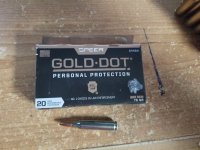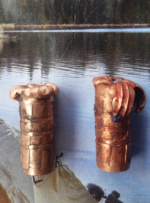I was actually listening to a podcast on my way from work today (The Big Game Hunting Podcast) and he had the Sierra guys on talking about their bullets. That's exactly what they said. The plastic tip falls off to the side when hitting the animal exposing the big hollow point.
This has been my experience as well. I had found several plastic tips off to the side in actual wound channels long before high speed photography became a thing.
In some cases, wound channels have been asymmetric, suggesting to me that the plastic tip can tear out of the hollow point as well.
I'm not an expert myself, just a terminal performance fanatic. I felt lucky to follow along with Hammer bullets as they developed their 'tipped' bullet line. A friend of mine was doing some serious testing for them and it was amazing to see his reports. Small changes in hollow point diameter and hollow point depth could result in significant changes to bullet performance on game. He culled thousands of Wallabies, hundreds of bovines and dozens of pachyderms. Not only that, he documented the results.
The big takeaway for me was that some of the designs were more consistent than others. The shape of the nose plays into it, but so do rarios like
Bullet length to. bullet diameter
Length of nose to length of shank
I'll reiterate again how changing one parameter could often result in vastly different performance on game. On the monolithic bullets, even small changes like .030" deeper hollow point could be the difference between consistent terminal performance and inconsistency.
Fordy calls a bullet that works across a wide range of impact velocities and target resistances a 'balanced pill'.
By all accounts, seems like the 77TMK might fit that description.
Just about any bullet will kill. Put it in the right place and good things happen.
Few will kill well, yielding DEEP and WIDE wound channels across a range of TARGET RESISTANCES and IMPACT VELOCITIES.









































































